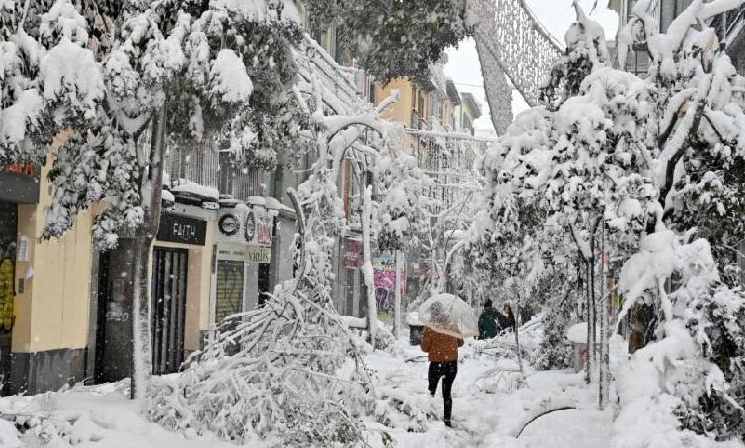By Hazel WARD
MADRID (AFP) — High among the treetops the sound of a chainsaw rings out and a huge branch comes crashing down as Madrid's forestry engineers move from tree to tree, repairing the damage from the record snowfall seen in January.
It has been over two months since Storm Filomena hit the Spanish capital, blanketing the city in the heaviest snowfall in 50 years.
But while delighted residents revelled in the winter wonderland, the weather event spelled disaster for Madrid's 1.7 million city-owned trees, with hundreds of thousands of branches collapsing under the weight of the snow.
"Some 800,000 trees were affected in one way or another. Of that number, 120,000 won't survive because they were totally uprooted or had to be felled," Borja Carabante, head of environmental issues at City Hall in Madrid, told AFP.
"The damage to our green heritage has been very significant."
Across the city, the devastation was shockingly evident, with streets and pavements blocked and the parks closed for six weeks.

'Environmental disaster'
"Everyone was very excited, but I felt huge sadness when I saw all the fallen trees," said Pablo Fernandez Santos, a senior forestry engineer, describing it as "an environmental disaster."
Worst-hit was Casa de Campo, a vast 1,500-hectare (3,800-acre) forest park west of the city, where 500,000 out of its 700,000 trees were damaged and one in five completely destroyed.
Even now, most of the park remains off-limits as the clean-up continues.
Evergreens — such as pines, holm oaks and cedars — bore the brunt, as their needles and leaves caught the snow.
By contrast, deciduous trees suffered far less, says Mariano Sanchez, a tree expert from Madrid's Botanical Gardens.
"Although the trees have adapted to cope with the wind and rain in Madrid, they weren't ready for this snowfall. They were overloaded, the wood couldn't support the weight and the branches broke."
Trees with very wide crowns may have supported up to "five or six tonnes" of snow, says Antonio Morcillo, deputy head of green conservation at City Hall.
In Madrid's historic Retiro park, 70 percent of its 17,400 trees were damaged, 1,000 of them beyond repair.
By comparison, the last major incident recorded in Madrid in 1885 was a typhoon that toppled 1,600 trees in the Retiro, Sanchez says.

'Green lungs'
The Spanish government has declared the area a catastrophe zone, "which means there's been very significant damage," says Carabante, estimating the total cost to be more than 100,000 euros ($120,000).
But the extent of the environmental impact on Madrid's "green lungs" remains unclear.
Trees generate huge benefits for cities such as carbon dioxide retention and pollution filtration, while also reducing the "urban heat-island" effect — increasingly important as climate change accelerates, experts say.
Juan Garcia Vicente of Spanish NGO Ecologists in Action says it is not yet clear how the damage will affect temperatures in a city with an arid climate that is getting hotter by the year.
"Not even the authorities know how much tree cover has been lost, they are looking at that now and how it could impact on the temperature," he told AFP.
"There is a widespread belief that trees are the solution… but you must go to the root of the problem.
"We have the highest levels in Europe of nitrogen dioxide emissions and you can't fix it by planting more trees but by improving transport."

Quality over quantity
Over the past two months, forestry experts have been involved in an intensive triage operation, which at its peak saw 3,500 people working to clear the damage.
"We have collected nearly 21,000 tonnes of remains," says conservation official Morcillo, as workers in green-and-yellow jumpsuits cut down wreckage from a battered pine and huge piles of branches were removed to be turned into compost or used to generate electricity.
While the urgent work is over, experts must keep a close eye on badly wounded specimens, says forestry engineer Fernandez Santos.
"Although many remain standing, they are very damaged and these wounds from broken branches or chainsaw pruning… make them more vulnerable to future storms or extreme weather events."
The city has set up a committee of experts to draw up a replanting strategy, the details of which will be published in the coming months.
For Sanchez, it is "an opportunity" to rethink the city's treescape and give new saplings the space to put down deep roots and grow without pruning.
"In a city, we need trees for shade, to remove contamination and provide oxygen. If you prune, they can't do that," he told AFP.
"It's about quality over quantity."
ADVERTISEMENT
ADVERTISEMENT


































